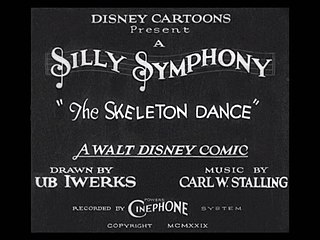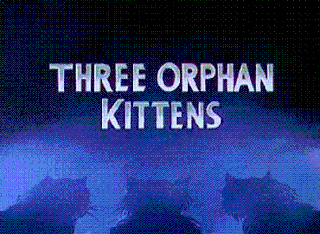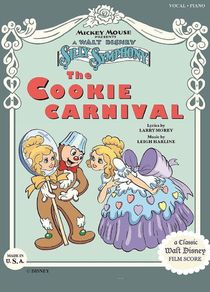Silly Symphony is an American animated series of 75 musical short films produced by Walt Disney Productions from 1929 to 1939. As the series name implies, the Silly Symphonies were originally intended as whimsical accompaniments to pieces of music. As such, the films usually did not feature continuing characters, unlike the Mickey Mouse shorts produced by Disney at the same time. The series is notable for its innovation with Technicolor and the multiplane motion picture camera, as well as its introduction of the character Donald Duck making his first appearance in the Silly Symphony cartoon The Wise Little Hen in 1934. Seven shorts won the Academy Award for Best Animated Short Film.

The Skeleton Dance is a 1929 Silly Symphony animated short subject produced and directed by Walt Disney and animated by Ub Iwerks. In the film, four human skeletons dance and make music around a spooky graveyard—a modern film example of medieval European "danse macabre" imagery. It is the first entry in the Silly Symphony series. In 1993, to coincide with the opening of Mickey's Toontown in Disneyland, a shortened cover of the cartoon's music was arranged to be featured in the land's background ambiance. The short's copyright was renewed in 1957, and as a published work from 1929 it will enter the US public domain on January 1, 2025.
Wild Waves is a Mickey Mouse short animated film first released on December 18, 1929, as part of the Mickey Mouse film series. It was the fifteenth Mickey Mouse short to be produced, the twelfth of that year, as well as the last to be released by Celebrity Productions before Columbia Pictures took over distribution.

Babes in the Woods is a 1932 Silly Symphonies animated film.
Summer is a Walt Disney short film released on January 16, 1930. Directed by Ub Iwerks, it is the sequel to the short Springtime (1929). It is 6 minutes long.
When the Cat's Away is a Mickey Mouse short animated film first released on May 3, 1929, as part of the Mickey Mouse film series. It was directed by Walt Disney and animated by Ub Iwerks and Ben Sharpsteen. It was the sixth Mickey Mouse short to be produced, the third of that year. In this cartoon, Mickey and Minnie are the size of regular mice, and Tom Cat is the size of a person.

Three Orphan Kittens is a 1935 animated short film in the Silly Symphonies series produced by Walt Disney Productions. It was the winner of the 1935 Oscar for Academy Award for Best Short Subject (Cartoons). It was followed in 1936 by a sequel, More Kittens.

The Cookie Carnival is an animated short produced by Walt Disney Productions and originally released May 25, 1935. It is a Cinderella story involving a cookie girl who wishes to be queen at the cookie carnival, and a homage to the Atlantic City boardwalk parade and bathing beauty contest of the 1920s and 1930s. Contrary to the claim in Film Superlist: 1894-1939, the film is not in the public domain as its copyright was renewed in 1964. It will enter the public domain in 2031 in accordance with current copyright laws.

El Terrible Toreador is a 1929 animated cartoon produced by Walt Disney Studios in the Silly Symphonies series. The short's copyright was renewed in 1957, so it will enter the US public domain on January 1, 2025.
Mother Goose Melodies is a 1931 Silly Symphonies animated film, directed by Burt Gillett. Two years later it was semi remade in Technicolor as Old King Cole.
Springtime is a Silly Symphonies animated Disney short film. It was released in 1929. It was the third Silly Symphonies film to be produced, just five days before the 1929 Stock Market Crash. The short's copyright was renewed in 1957, so it will enter the US public domain on January 1, 2025.
The China Plate is a 1931 Silly Symphonies animated film.
Frolicking Fish is a Silly Symphonies animated Disney short film. It was released in 1930.
Arctic Antics is a Silly Symphonies animated Disney short film. It was released on June 26, 1930.
Night is a Silly Symphonies animated Disney short film. It was released in 1930 by Columbia Pictures.
Monkey Melodies is a Silly Symphonies animated Disney short film. It was released in 1930 as the 13th film in the Silly Symphony Series.
The Cat's Out is a Silly Symphonies animated Disney short film. It was released in 1931. The Cat's Out was a working title that survives on an existing vault print; the short was originally copyrighted and released as The Cat's Nightmare.

The Goddess of Spring is a 9-minute Silly Symphonies animated Disney short film. The Symphony is imbued with operatic themes and is often cited as melodramatic. It was released in 1934, and its production was important to the future development of Disney's Snow White and the Seven Dwarfs animation. Each Silly Symphony was a technological marvel at the time and proceeded to further advancements in the animation industry.

The Haunted House, also known as Haunted House, is a 1929 Mickey Mouse short animated film released by Celebrity Productions, as part of the Mickey Mouse film series. The cartoon was produced by Walt Disney Productions and distributed by Celebrity Productions. It was the fourteenth Mickey Mouse short to be produced, the eleventh of that year.
Hell's Bells is a 1929 animated short film was directed by Ub Iwerks and was distributed into cinemas by the film company Columbia Pictures, who would also distribute other Walt Disney films, such as Winter. The film follows Satan and the other devils' happenings in Hell. One of these devils revolts against Satan, and end up kicking him off the cliff of Hell at the end of the film. The short is part of short film series Silly Symphonies.







